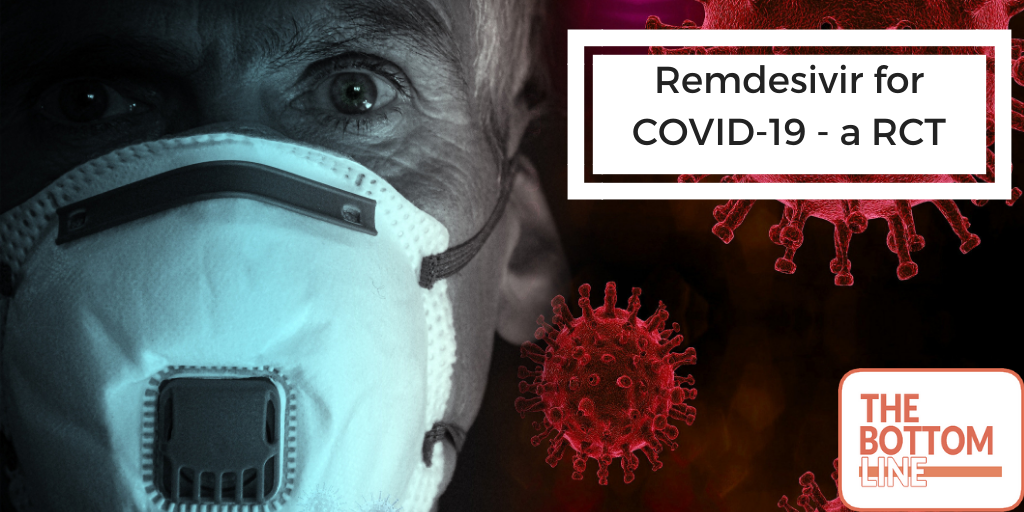Wang

Remdesivir in adults with severe COVID-19: a randomised, double-blind, placebo-controlled, multicentre trial
Wang Y. Lancet; Epub Ahead of Print. doi: https://doi.org/10.1016/S0140-6736(20)31022-9
Clinical Question
- In patients with severe COVID-19, does intravenous remdesivir, compared with placebo, improve the time to clinical improvement?
Background
- Despite the ongoing research efforts to find a treatment for patients infected with SARS-CoV-2, there are currently no proven therapies shown to be safe and effective
- The identification of a safe and effective treatment for COVID-19 would be a turning point in medicine
- Prior investigations into the use of hydroxychloroquine and lopinavir-ritonavir did not demonstrate efficacy
- Remdesivir, a nucleoside analogue prodrug, has inhibitory effects on pathogenic animal and human coronaviruses, including severe acute respiratory syndrome coronavirus 2 (SARS-CoV-2) in vitro, and inhibits Middle East respiratory syndrome coronavirus, SARS-CoV-1, and SARS-CoV-2 replication in animal models
Design
- Investigator-initiated, individually randomized, placebo-controlled, double-blind trial
- Patients were randomly assigned (2:1) to either remdesivir or placebo
- Block randomization stratified on basis of respiratory support:
- 1: no oxygen support or oxygen support with nasal duct or mask
- 2: high-flow oxygen, non-invasive ventilation, invasive ventilation, or extracorporeal membrane oxygenation
- Block randomization stratified on basis of respiratory support:
- The primary efficacy analysis was done on an intention-to-treat (ITT) basis with all randomly assigned patients
- Registered with clinicaltrials.gov
- Trial stopped early on the basis of the termination criteria specified in the protocol being met and the control of the outbreak in Wuhan
- The original design required a total of 325 events across both groups to provide 80% power, to detect a change in time to clinical improvement of 6 days, assuming that time to clinical improvement was 21 days on placebo
- The actual enrollment saw 236 participants, reducing the statistical power from 80% to 58%
Setting
- Ten hospitals in Wuhan, Hubei, China
- Study conducted from Feb 6, 2020 to March 12, 2020
Population
- Inclusion: Men and non-pregnant women with COVID-19
- At least 18 years old
- RT-PCR positive for SARS-CoV-2
- Pneumonia confirmed by chest imaging
- Oxygen saturation of 94% or lower on room air or a ratio of arterial oxygen partial pressure to fractional inspired oxygen of <= 300 mm Hg
- Within 12 days of symptom onset
- Exclusion:
- Pregnancy or breast feeding
- Hepatic cirrhosis
- AST or ALT more than five times the upper limit of
normal - Known severe renal impairment
- Estimated GFR <30 mL/min/1.73 m²
- Receipt of CRRT, HD, or PD
- Possibility of transfer to a non-study hospital within 72 h
- Enrollment into an investigational treatment study for COVID-19 in the 30 days before screening
- Comparing baseline characteristics of remdesivir (n=158) vs. placebo group (n=78)
- Age: 66 vs. 64
- Male: 56% vs. 65%
- Co-morbidities
- Hypertension: 46% vs. 38%
- Diabetes: 25% vs. 21%
- Coronary heart disease: 9% vs. 3%
- Respiratory rate >24: 23% vs. 14%
- Serum creatinine: 68 vs. 71 umol/L
- LDH: 339 vs. 329
- National Early Warning Score 2 at day 1: 5 vs. 4
- Six category scale at day 1
- 2: hospital admission not requiring supplementary oxygen: 0% vs. 4%
- 3: Hospital admission requiring supplementary oxygen: 82% vs. 83%
- 4: Hospital admission requiring high-flow oxygen or non-invasive ventilation: 18% vs. 21%
- 5: Hospital admission requiring ECMO or invasive mechanical ventilation: 0% vs. 1%
- 6: Death: 1% vs. 0%
- At baseline receiving:
- Interferon alfa-2b: 18% vs. 19%
- Lopinavir-ritonavir: 17% vs. 19%
- Corticosteroids: 38% vs. 40%
- Time from symptom onset to starting study treatments: 11 (IQR 9-12) vs. 10 (9-12) days
- Early (<=10 days from symptom onset 46% vs. 60%
- Late: (>10 days from symptom onset): 54% vs. 40%
- Highest oxygen therapy support received before and after enrollment
- Non-invasive ventilation: 9% vs. 4%
- Invasive mechanical ventilation: 7% vs. 13%
- ECMO: 1% vs. 0%
Intervention
- Remdesivir
- Intravenous remdesivir 200 mg on day 1 followed by 100 mg on days 2–10 in single daily infusions
Control
- Placebo
- Placebo infusions for a total of 10 days, matching the volume of the intravenous remdesivir infusions
Management common to both groups
- Other treatments including lopinavir-ritonavir, interferon alfa-2b, vasopressors, antibiotics, and corticosteroids were allowed
- Daily monitoring for adverse events, clinical laboratory testing (days 1, 3,
7, and 10), 12-lead electrocardiogram (days 1 and 14), and daily vital signs measurements - Nasopharyngeal or oropharyngeal swabs, expectorated sputa as available, and fecal or anal swab specimens were collected on days 1, 3, 5, 7, 10, 14, 21, and 28 for viral RNA detection and quantification
Outcome
- Primary outcome:
- Time to clinical improvement within 28 days after randomization – no significant difference
- Defined as a two-point reduction in patients’ admission status on a six-point ordinal scale, or live discharge from the hospital, whichever came first
- 1: discharged or having reached discharge criteria (defined as clinical recovery—ie, normalization of pyrexia, respiratory rate <24 breaths per minute, saturation of peripheral oxygen >94% on room air, and relief of cough, all maintained for at least 72 h)
- 2: hospital admission but not requiring oxygen therapy
- 3: hospital admission for oxygen therapy (but not requiring high-flow or non-invasive ventilation)
- 4: hospital admission for noninvasive ventilation or high-flow oxygen therapy
- 5: hospital admission for extracorporeal membrane oxygenation or mechanical ventilation
- 6: death
- Median 21 days (IQR 13–28) in the remdesivir group vs 23 days in placebo group (15–28); HR 1.23 (95% CI 0.87–1.75)
- Defined as a two-point reduction in patients’ admission status on a six-point ordinal scale, or live discharge from the hospital, whichever came first
- Time to clinical improvement within 28 days after randomization – no significant difference
- Secondary outcomes – comparing remdesivir vs. placebo groups, no significant differences observed
- Proportions of patients in each category of the six-point scale at day 7, 14, and 28 after randomization
- Day 7: OR 0.69 (0.41 to 1.17)
- Day 14: OR 1.25 (0.76 to 2.04)
- Day 28: OR 1.15 (0.67 to 1.96)
- All-cause mortality at day 28
- 14% vs. 13%; difference 1.1% (95% CI –8·1 to 10.3)
- Duration of mechanical ventilation
- Median 7 days (IQR 4 to 16) vs. 15.5 (6 to 21) days; difference –4 (95% CI –14 to 2)
- Duration of oxygen therapy
- Median 19 days (IQR 11 to 30) vs. 21 (14 to 30.5) days; difference –2 (95% CI –6 to 1)
- Duration of hospital admission
- Median 25 days (IQR 16 to 38) vs. 24 (18 to 36) days; difference 1 (95% CI –4 to 4)
- Proportions of patients in each category of the six-point scale at day 7, 14, and 28 after randomization
- Virological measures – no significant differences observed:
- Proportions of patients with viral RNA detected and viral RNA load
- Safety outcomes, comparing remdesivir vs. placebo groups
- Treatment-emergent adverse events
- 66% vs. 64%
- Serious adverse events
- 18% vs. 26% in the control group
- Premature discontinuations of study drug
- 12% vs. 5%
- Of these patients, 39% in the remdesivir group were due to respiratory failure or acute respiratory distress syndrome
- 12% vs. 5%
- Treatment-emergent adverse events
- Post-hoc analysis
- In patients receiving study drug within 10 days of symptom onset
- Time to recover in remdesivir vs. placebo groups – no significant difference
- 18 days (IQR 12-28) vs. 23 days (15-28), HR 1.52 (0.95-2.43)
- 28 day mortality – no significant difference
- 11% vs. 15% (difference -3.6% (-16.2 to 8.9)
- Time to recover in remdesivir vs. placebo groups – no significant difference
- In patients receiving study drug within 10 days of symptom onset
Authors’ Conclusions
- “…this dose regimen of intravenous remdesivir was adequately tolerated but did not provide significant clinical or antiviral effects in seriously ill patients with COVID-19. However, we could not exclude clinically meaningful differences and saw numerical reductions in some clinical parameters.”
Strengths
- Intention-to-treat design using all randomly assigned patients
- Use of placebo
- Multi-centre
- Relatively large enrollment and well-designed trial in an area with a significant number of COVID-19 cases
Weaknesses
- Terminated early after stringent measures in Wuhan led to a decline in the number of patients presenting with COVID-19
- Power was not met; the lower enrollment reduced statistical power from 80% to 58%
- This exposes the study to increased Type II error (falsely negative results)
- The median time to treatment with remdesivir was 10 days; this may be outside of the window of opportunity to benefit from the drug
- The authors state that they were unable to adequately assess whether earlier remdesivir treatment might have provided clinical benefit
- Limited hospital bed availability prevented admission earlier in disease progression
- The lack of impact on viral load may suggest that remdesivir was administered too late in the disease progression
- Lopinavir–ritonavir was co-administered in 42 (18%) patients at baseline, however a previous study did not demonstrate lopinavir-ritonavir to be effective in patients with COVID-19 thus this may not have had a substantial confounding effect
- Absence of data on infectious virus recovery or on possible emergence of reduced susceptibility to remdesivir
- Most patients were in category 3 of the six-point ordinal scale of clinical status at baseline
- Is this the patient population most likely to benefit from remdesivir?
- “The frequent use of corticosteroids in our patient group might have promoted viral replication, as observed in SARS and MERS, although these studies only reported prolongation of the detection of viral RNA, not infectious virus”
The Bottom Line
- A relatively large but underpowered trial failed to demonstrate efficacy with intravenous remdesivir when administered relatively late in disease progression for COVID-19
- Viral load was not shown to be diminished in clinical practice despite preliminary data
External Links
- Article: Wang et al. Remdesivir in adults with severe COVID-19: a randomised, double-blind, placebo-controlled, multicentre trial
- Further reading: REBEL EM. COVID-19: Two More Trials Just Published on Remdesivir
- Further reading: PulmCrit – First placebo-controlled RCT on remdesivir for COVID-19
Metadata
Summary author: Daniel Hu, PharmD, BCCCP
Summary date: 5/1/2020
Peer-review editor: David Slessor



